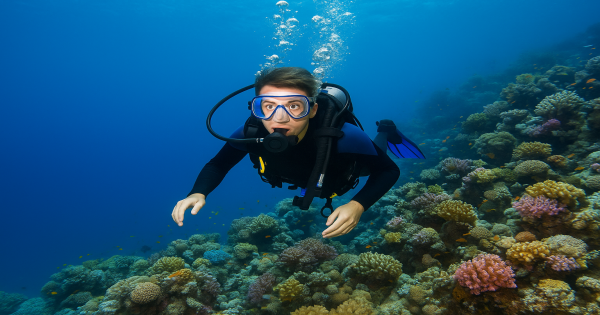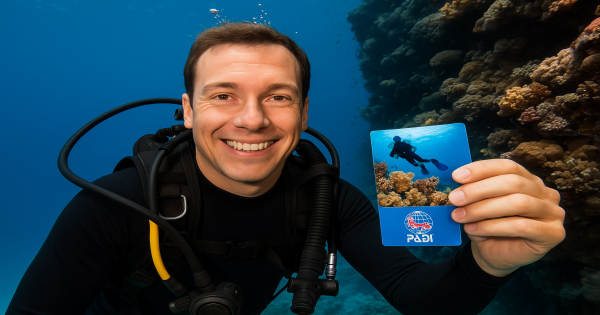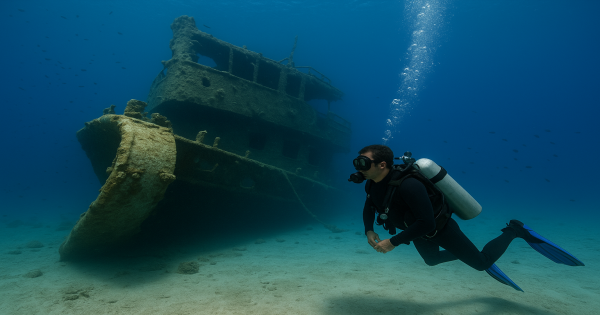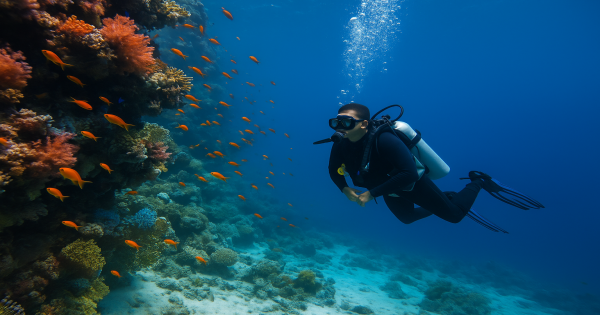Blog Details
rescue diver certification
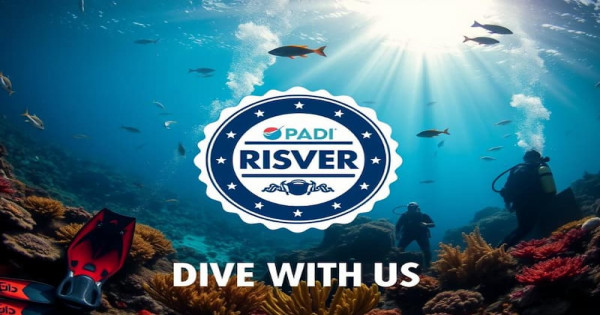
The PADI Rescue Diver certification is a big step for scuba divers. It helps them learn how to handle emergencies and rescue others. This makes diving safer for everyone.
To become a PADI Rescue Diver, you go through a detailed training. You learn how to save yourself and others. You also learn how to rescue people underwater.
Getting this certification gives divers the confidence to handle emergencies. They become a key part of any diving team. This is thanks to a well-structured training program.
Key Takeaways
- The PADI Rescue Diver certification is a comprehensive scuba diving course that equips divers with rescue techniques.
- The certification covers self-rescue skills, assisting distressed divers, and surface and underwater rescue methods.
- A rescue diver certification is essential for divers who want to enhance their skills and knowledge in rescue techniques.
- The certification makes diving safer for themselves and others.
- The journey to becoming a PADI Rescue Diver involves a comprehensive training program in underwater rescue training.
- Obtaining a rescue diver certification can gain divers the confidence and skills needed to respond to emergency situations.
Understanding the PADI Rescue Diver Certification Program
The PADI Rescue Diver certification is a top honor for divers. It shows they can handle emergency situations. It's a key step for those wanting to improve their scuba skills and help others in need. With PADI, divers know they're getting top-notch training that's respected everywhere.
Students in the PADI Rescue Diver program learn a lot. They get both theory and hands-on training. They learn how to save themselves and others, manage stress, and use rescue techniques. It's a tough but rewarding course that boosts their confidence and skills.
What is a Rescue Diver?
A rescue diver is a pro who knows how to act in emergencies. They stay calm and use their skills to help others. Becoming a rescue diver is a big step up for any diver, giving them the confidence to handle emergencies.
Why Choose PADI Certification?
PADI certification is known worldwide as the best in scuba diving. It means you're getting top training that meets all diver levels. PADI offers many programs, from beginner to advanced, helping divers reach their goals. Whether you want to teach diving or just improve your skills, PADI has the right program for you.
Course Overview and Duration
The PADI Rescue Diver program takes a few days. It mixes theory and practice, making it both tough and rewarding. You'll learn important skills like emergency planning, self-rescue, and managing stress in others.
- Emergency response planning
- Self-rescue techniques
- Recognizing and managing stress in other divers
- Applying rescue techniques in emergency situations
Getting the PADI Rescue Diver certification is a big achievement. It shows you're ready to handle emergencies. With PADI, you know you're getting the best training that's recognized globally.
Essential Prerequisites for Your Rescue Diver Journey
To start the scuba rescue course, you must meet certain requirements. These steps make sure divers are ready for the course's challenges. You need a current CPR and first aid certification and be at least 15 years old.
It's also important to know diving basics well. This knowledge comes from previous diving certifications, like the PADI Advanced Open Water Diver. Having this background is key for a successful rescue diver journey. By fulfilling these requirements, you can confidently join a diving safety certification program, like the scuba rescue course. This way, you'll learn how to handle emergencies.
Some key prerequisites to keep in mind include:
- Current CPR and first aid certification
- Minimum age of 15 years old
- Previous diving certifications, such as PADI Advanced Open Water Diver
By understanding and meeting these prerequisites, individuals can set themselves up for success in the scuba rescue course and enhance their diving skills certification.
| Prerequisite | Description |
|---|---|
| CPR and first aid certification | Current certification in CPR and first aid |
| Minimum age | At least 15 years old |
| Previous diving certifications | PADI Advanced Open Water Diver or equivalent |
Women Breaking Boundaries in Rescue Diving
Women are key in the diving world, and their role in rescue diving is highly valued. DIVE WITH US supports female diving professionals, helping them grow and improve their skills.
Female divers can get rescue diver certification for women. This certification lets them face new challenges and make a big difference in the diving world. Women in diving are setting new standards and inspiring others to join them.
DIVE WITH US celebrates PADI Women's Day with special events and deals. They aim to encourage more women to dive and pursue diving careers. Some key efforts include:
- Workshops and training sessions just for women in diving
- Scholarships and grants for female divers to get rescue diver certification
- Mentorship programs to link experienced female divers with new ones
By backing women in diving and offering chances for growth, DIVE WITH US is making the diving community more diverse and welcoming.
| Initiative | Description |
|---|---|
| PADI Women's Day | Celebration with special events and promotions to inspire women in diving |
| Rescue Diver Certification for Women | Empowers female diving professionals to take on new challenges and make a meaningful impact |
| Mentorship Programs | Connects experienced female divers with newcomers to the sport |
Core Components of Rescue Diver Training
The Rescue Diver training program teaches divers how to handle emergencies. It covers self-rescue skills, managing stress in others, and helping distressed divers at the surface and underwater.
The main parts of the training are:
- Learning underwater rescue methods for emergencies
- Getting self-rescue skills to stay safe in emergencies
- Knowing how to assist distressed divers and handle stress
By learning these key parts, divers become more confident and skilled in emergencies.
With the right training, divers can handle emergencies well. This makes diving safer and more fun for everyone.
Mastering Emergency Response Techniques
Emergency response training is key for Rescue Diver certification. It teaches divers how to act in emergencies. This training is part of a scuba rescue course, which focuses on managing emergencies and helping distressed divers.
As part of the dive instructor certification, divers learn many skills. They learn self-rescue techniques, like navigating underwater and managing air. They also learn to help distressed divers, spotting panic signs and acting quickly.
They must master surface and underwater rescue methods. This includes safely bringing a distressed diver to the surface and caring for them until medical help arrives.
Key Emergency Response Skills
- Self-rescue skills, such as navigating through underwater obstacles
- Assisting distressed divers, including recognizing signs of panic or other emergencies
- Surface and underwater rescue methods, including safely bringing a distressed diver to the surface
By learning these skills, divers can make their diving safer and more enjoyable. The scuba rescue course and emergency training are vital for the Rescue Diver certification. They give divers the knowledge and skills to handle emergencies well.
Your Rescue Diver Certification Timeline
Getting certified as a rescue diver is exciting. But, knowing the rescue diver certification timeline is key. The time it takes to finish the course depends on your experience and how often you train.
The course mixes learning and doing. You'll study and then practice what you've learned. This can take a few days to a week, based on your schedule. Here's what you need to know:
- Theoretical study: 1-2 days
- Practical training sessions: 2-4 days
- Exam and certification: 1 day
Make sure you have enough time for studying and practicing. The scuba diving course duration might seem short. But, it's filled with important lessons and hands-on training to make you a skilled rescue diver.
Knowing the rescue diver certification timeline and the scuba diving course duration helps you prepare. Stay focused and work hard. You'll be on your way to becoming a certified rescue diver in no time.
Equipment Requirements and Considerations
Having the right gear is key for rescue diving. It keeps both the diver and the person being rescued safe. You'll need first aid kits, oxygen units, and ways to communicate. Scuba gear like masks, fins, and tanks must also be ready for rescue work.
Think about what rescue equipment you'll need. This could be rescue ropes, flotation devices, and emergency beacons. Keeping your gear in top shape is crucial. Knowing how to use and maintain this equipment is a big part of Rescue Diver training.
Essential Safety Gear
- First aid kits
- Oxygen units
- Communication devices
- Rescue ropes
- Flotation devices
- Emergency beacons
With the right diving safety equipment, scuba gear, and rescue equipment, you can do a safe and successful rescue. Remember, practicing and training with this gear helps build confidence and skill.
Maintenance and Care Tips
Keeping your gear in good shape is vital. Always check it before diving, clean it well, and store it right. Regular inspections are also a must.
| Equipment | Maintenance | Care |
|---|---|---|
| Scuba gear | Regular inspections | Proper storage |
| Rescue equipment | Functionality checks | Regular cleaning |
Building Confidence Through Practice Scenarios
Rescue diving practice is key for gaining diving confidence. Divers learn by taking part in emergency response scenarios. This hands-on training makes them more comfortable and confident in emergency situations.
Through practice, divers find out where they need more training. They can then work on improving those skills. Emergency response scenarios include handling a distressed diver or managing a diving emergency. Practicing these scenarios helps divers develop the skills and confidence needed for real-life emergencies.
Some key benefits of rescue diving practice include:
- Improved diving confidence
- Enhanced emergency response skills
- Increased ability to respond to unexpected situations
Rescue diving practice is a vital part of any rescue diving training. It helps divers develop the skills and confidence needed to be effective rescue divers. This can lead to safer diving and fewer accidents. As divers gain more experience and confidence, they can take on more challenging roles, like leading expeditions or teaching others.
Overall, rescue diving practice is a crucial part of any rescue diving training program. It gives divers the chance to practice and apply their skills in a controlled setting. This helps build diving confidence and improves emergency response skills.
The Role of Physical Fitness in Rescue Diving
Being physically fit is key for rescue diving. It lets divers do hard tasks when emergencies happen. They need good heart health, muscle strength, and flexibility.
Swimming and running help improve heart health. Strength training boosts muscle endurance. These exercises are important for rescue divers.
Health is also a big deal in rescue diving. Some health issues might stop a diver from doing rescue work safely. It's important for all divers to stay healthy and get regular check-ups.
Yoga and stretching can make divers more flexible. This helps prevent injuries. It's good for all divers, especially those in rescue.
To stay fit for diving, rescue divers should focus on a few key areas:
- Cardiovascular fitness: Do regular aerobic exercises like swimming, cycling, or running. This improves heart health and endurance.
- Strength training: Add strength exercises like weightlifting or bodyweight exercises. This builds muscle endurance and power.
- Flexibility and mobility: Do stretching and flexibility exercises like yoga or Pilates. This improves range of motion and lowers injury risk.
By focusing on physical fitness and health, divers can meet the demands of rescue diving. Regular exercise and a healthy lifestyle are key. They help divers stay fit and reduce injury or illness risk.
| Physical Fitness Component | Importance in Rescue Diving |
|---|---|
| Cardiovascular fitness | Enables divers to perform strenuous tasks in emergency situations |
| Strength training | Enhances muscular endurance and power |
| Flexibility and mobility | Improves range of motion and reduces the risk of injury |
Career Opportunities After Certification
After becoming a certified PADI Rescue Diver, you'll find many diving career opportunities. You can become a scuba diving instructor. This lets you teach others and share your diving knowledge.
Popular rescue diver jobs include working in dive shops or on liveaboard vessels. You can also join marine conservation efforts. Employers value the skills you gain from the Rescue Diver certification. This makes you a strong candidate in the diving job market. Here are some career paths to explore:
- Dive shop staff or manager
- Liveaboard diving vessel crew member
- Marine conservation team member
- Scuba diving instructor or trainer
With the right training and experience, your career options are vast. Whether you aim for a full-time diving career or want to teach others, starting as a PADI Rescue Diver is key.
| Career Path | Description |
|---|---|
| Dive Shop Staff | Assist customers with equipment purchases and rentals, provide diving advice and guidance |
| Liveaboard Diving Vessel Crew | Work on a diving vessel, leading dives and providing safety support to passengers |
| Marine Conservation | Work on conservation projects, using diving skills to protect and preserve marine ecosystems |
Starting Your Journey with DIVE WITH US
Starting your scuba diving adventure with DIVE WITH US is thrilling. Our diving certification programs offer a full and supportive learning environment. They are perfect for both beginners and experienced divers, covering various skill levels and interests.
Looking to begin? Check out our course schedules, which fit many lifestyles. We also have payment plans and options to help make our programs more affordable.
Course Scheduling and Payment Options
- Flexible scheduling to accommodate different lifestyles
- Payment plans and options for diving certification programs
- Special promotions and events, such as those celebrating PADI Women's Day
Location and Facilities
Our facilities and equipment are top-notch, ensuring the best training for divers. Located in a convenient spot, DIVE WITH US is ideal for starting your Rescue Diver journey. Contact us at +201092856966 for more information on courses, schedules, and promotions.
Conclusion: Embracing the Challenge of Rescue Diving
Becoming a PADI Rescue Diver is a journey that pushes divers to grow. It teaches them skills for emergency situations. The process might seem tough, but the feeling of accomplishment is worth it.
For those looking to improve their diving skills, rescue diving is the way. It offers chances for growth and personal achievement. With the right help and dedication, anyone can learn to help in emergencies.
At DIVE WITH US, we help people reach their diving dreams. We offer detailed training, hands-on practice, and support. Our goal is to prepare our students to excel in this exciting field.
FAQ
What is a Rescue Diver?
A Rescue Diver is a scuba diver trained to handle emergencies underwater. They learn how to rescue others and respond to emergencies. This training shows they are skilled in rescue techniques.
Why choose PADI certification for Rescue Diver?
PADI is a top name in scuba diving education. Choosing PADI means you're getting a well-respected program. It's known for quality and is recognized worldwide.
What are the prerequisites for the Rescue Diver course?
To start the Rescue Diver course, you need a few things. You must be at least 15 years old and have a CPR and first aid certification. You should also know diving basics, like those learned in the PADI Advanced Open Water Diver course.
How can women get involved in rescue diving?
DIVE WITH US supports and empowers female divers. They celebrate PADI Women's Day with special events. This center is a great place for women to grow their diving skills and inspire others.
What are the core components of Rescue Diver training?
Rescue Diver training covers a lot. You learn how to save yourself and others. You also learn about managing stress and using rescue gear. It's all about being ready for emergencies.
How long does it take to complete the Rescue Diver certification?
The time it takes to get certified varies. It depends on your experience and how often you train. The course mixes theory and practice, usually taking a few days to a week.
What kind of equipment is required for rescue diving?
Rescue diving needs the right safety gear. This includes first aid kits, oxygen units, and communication tools. Your scuba gear must also be in top shape. Keeping your equipment well-maintained is crucial for safety.
How does physical fitness affect rescue diving?
Being fit is key for rescue diving. You might need to do hard tasks in emergencies. To stay fit, try swimming, running, and strength exercises. Remember to consider any health issues that might affect your diving.
What career opportunities are available after becoming a Rescue Diver?
Being a PADI Rescue Diver opens doors in the diving world. You can become a diving instructor or work in dive shops. Your skills are valuable in many diving jobs.
How can I get started with the Rescue Diver course at DIVE WITH US?
To start the Rescue Diver course at DIVE WITH US, call +201092856966. They'll help with schedules, payment, and special deals. DIVE WITH US offers flexible learning and top facilities.
